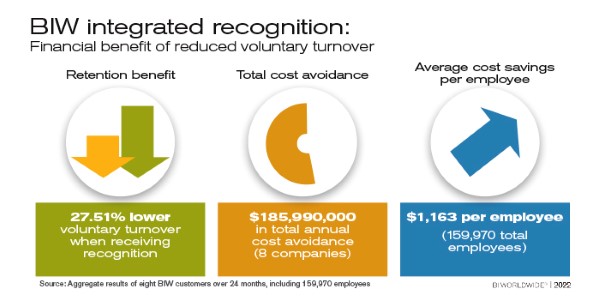The challenge of retaining employees
A huge issue organisations face is how to attract and retain employees. Companies must anticipate impending shortages of overall talent as well as a shortfall of employees with the specialised competencies needed to stay ahead of the competition.
In this blog, we explore six proven employee retention strategies that can help your organisation navigate these challenges, build a dedicated workforce, and drive exceptional business results.
- What impacts employee retention?
- Best practices for employee retention
- The financial impact of talent mobility and recognition programmes
- Six proven employee retention strategies
- How can you maximise your recognition budget for optimal impact?
What impacts employee retention?
Studies have shown that employees typically follow four primary paths to turnover, each of which has different implications for an organisation:
Employee dissatisfaction
Attack this issue with traditional retention strategies such as monitoring workplace attitudes and addressing the drivers of turnover.
Better alternatives
Retain employees by ensuring that the organisation is competitive in terms of rewards, developmental opportunities, and the quality of the work environment. Be prepared to deal with external offers for valued employees.
A planned change
Some employees may have a predetermined plan to quit (e.g., if their spouse becomes pregnant, if they get a job advancement opportunity, if they are accepted into a degree programme). However, increasing rewards tied to tenure or in response to employee needs may alter the plans of some employees.
For example, if a company is seeing exits based on family-related plans, more generous parental leave and family-friendly policies may help reduce the impact.
A negative experience
Employees sometimes leave on impulse, without any plan for the future. Generally, this is the result of a negative response to a specific action (e.g., being passed over for a promotion or experiencing difficulties with a manager).
Analyse the types and frequencies of work-related issues that are driving employees to leave. Provide management training to minimise prevalent negative interactions (e.g., harassment, bullying, or unfair and inconsistent treatment) and provide support mechanisms to deal with those problems (e.g., conflict resolution procedures, alternative work schedules or employee assistance programmes).
Best practices for employee retention
Practices that contribute to staff retention arise in all areas of human resources (HR), and all roles within an organisation will need to work together to develop and implement multifaceted retention strategies. Broad-based and targeted strategies, or a combination of both, may be appropriate depending on the circumstances.
Effective practices in a number of areas can be especially powerful in enabling an organisation to achieve its retention goals. These areas include:
Recruitment
Effective recruitment practices are crucial not only for attracting top talent but also for fostering long-term engagement throughout the employee engagement life cycle.
Recruitment practices can strongly influence turnover, and considerable research shows that presenting applicants with a realistic job preview during the recruitment process has a positive effect on the retention of those new hires.
Moreover, integrating engagement-focused elements into the recruitment process, such as showcasing opportunities for growth, emphasising organisational values, and promoting a supportive work environment, can further bolster employee commitment from day one.
Onboarding/employee career mobility turnover
It’s often high among new employees. Socialisation practices—delivered via a strategic onboarding and assimilation programme—can help new hires become embedded in the company and thus more likely to stay. These practices include shared and individualised learning experiences, formal and informal activities that help people get to know one another, and the assignment of more seasoned employees as role models for new hires.
Training and development
If employees are not given opportunities to continually update their skills, they are more inclined to leave.
Continuous learning opportunities signal to employees that the organisation is committed to their growth and career advancement. By providing access to training workshops, certifications, mentorship programmes, and ongoing skill development initiatives, organisations not only equip their employees with the tools needed to excel in their current roles but also prepare them for future challenges and opportunities.
Employee recognition strategies
Pay levels and satisfaction are only modest predictors of an employee’s decision to leave the organisation; however, a company has three possible employee recognition strategies:
- Lead the market with respect to compensation and rewards.
- Tailor rewards to individual needs in a person-based pay structure.
- Explicitly link rewards to retention.
Manager engagement
Several studies have suggested that fair treatment by a manager is the most important determinant of retention. This would lead a company to focus on supervisory and management development and communication skill-building.
Employee engagement
Engaged employees are satisfied with their jobs, enjoy their work and the organisation, believe that their job is important, take pride in their company, and believe that their employer values their contributions.
Implementing effective employee engagement programmes can significantly boost engagement levels and reduce turnover rates. One study found that highly engaged employees were 5x less likely to quit than employees who were not engaged.
The financial impact of talent mobility and recognition programmes
Understanding the financial benefits of talent mobility and strategic recognition spending is crucial for any organisation. Reducing attrition and increasing productivity are key outcomes of effective talent management.
- Reduce attrition and increase productivity.
- 59% of people are at their most productive when working remotely, whether at home or in a public space like a café (Avast Business).
- A 2021 report from Gallup found workers are most engaged when working remotely 60-80% of the time (Gallup).
- Talent mobile managers are more effective and experience lower turnover.
- 50% of employees leave a job or company due to a bad manager sometime within their career. (Gallup).
- Increase innovation.
- A talented mobile workforce opens avenues for companies to utilise a greater pool of expertise from around the globe, thus allowing companies to curate more innovative thinking (Harvard Online).
- Organisations that embrace open innovation have a 59% higher rate of revenue growth compared to those that don’t (IBM).
Six proven employee retention strategies
High employee turnover not only disrupts productivity but also incurs considerable costs for recruitment and training.
To help you maintain a stable and motivated workforce, we’ve identified six proven strategies on how to retain employees effectively.
1 – Activate talent mobility
Activate talent mobility across all career journeys or paths by connecting all essential elements such as people, platforms, and opportunities. This involves creating a cohesive ecosystem where employees can seamlessly move between roles and departments.
By maximising investments in learning and development, you can ensure that employees are continuously enhancing their skills and knowledge. This not only benefits the company by having a more skilled and adaptable workforce but also benefits employees by providing them with diverse career opportunities and professional growth.
2 – Enhance talent journeys
Accelerate, enhance, reinforce, and increase the effectiveness of talent journeys or paths by focusing on areas such as new-hire onboarding, upskilling/reskilling, personal growth plans (PGP), and leadership development.
Continuous upskilling and reskilling opportunities ensure that employees can adapt to changing job requirements and stay relevant in their roles. PGPs tailored to individual career aspirations encourage employees to take control of their professional development, while leadership development programmes prepare future leaders to guide the organisation effectively.
3 – Reduce turnover
Reduce physical and mental resignations by hiring within. LinkedIn’s Global Talent Trends 2020 report found that employees stick around 41% longer at companies that regularly hire from within.
By prioritising internal candidates for open positions, organisations can boost employee morale and engagement. Internal hiring not only demonstrates a commitment to employee growth but also leverages the existing knowledge and experience of current employees. This strategy reduces recruitment costs, shortens onboarding times, and fosters a culture of loyalty and staff retention.
4 – Create career visibility
Create a line of sight for employees, managers and leaders regarding career journeys or paths, opportunities, progress, impact, etc. Transparent communication about career development opportunities and potential career paths helps employees understand how they can grow within the organisation.
Regular feedback and progress tracking ensure that employees are aware of their development and the impact of their contributions. Providing visibility into career paths and opportunities helps align employee aspirations with organisational goals, thereby increasing motivation and engagement.
5 – Build a connected community
Help build a community of sorts to foster stronger connections, especially given hybrid and work from home models, and identify, develop, and link talent; leverage social/mobile; reciprocal two-way street (employee and company).
Encouraging collaboration and communication across different teams and departments can create a sense of belonging and unity. Virtual events, forums, and social groups can help maintain strong connections among remote workers. By fostering a supportive community, organisations can enhance employee engagement and satisfaction, which in turn can boost productivity and innovation.
6 – Inspire and reward teams
Inspire, support, recognise and reward the achievements of (in)formal, ad hoc and/or cross-functional teams for identifying, defining, and resolving issues and/or achieving stated goals. Teams create a stronger sense of community. Informal, ad hoc and/or cross-functional teams are an excellent opportunity to engage and develop high-potential employees.
Recognising and celebrating team achievements not only boosts morale but also encourages a collaborative and innovative work environment. Providing rewards and incentives for successful team initiatives can motivate employees to contribute their best efforts. Informal and ad hoc teams, in particular, can foster creativity and allow employees to take on new challenges, thereby enhancing their skills and experience.
How can you maximise your recognition budget for optimal impact?
At BI WORLDWIDE, we believe the best and most impactful way to utilise your recognition budget is to implement a three-dimensional strategy that encompasses base recognition, strategic recognition, and performance-based recognition. Each of these levels has its own distinct focus, features, and programmes.

This three-dimensional, integrated recognition strategy has been implemented by multiple BIW clients and has led to significant reductions in voluntary turnover and major financial benefits as evidenced below.

Retain your best talent with employee recognition from BI WORLDWIDE
Creating a supportive and motivating work environment is essential for retaining top talent. At BI WORLDWIDE, we specialise in developing tailored employee retention programmes. Our comprehensive employee recognition programmes and global reward marketplace are designed to celebrate and reward your employees’ achievements, fostering a culture of appreciation and continuous engagement.
Learn about our innovative employee engagement solutions
Discover how we can help you retain your best talent and build a thriving workplace.
